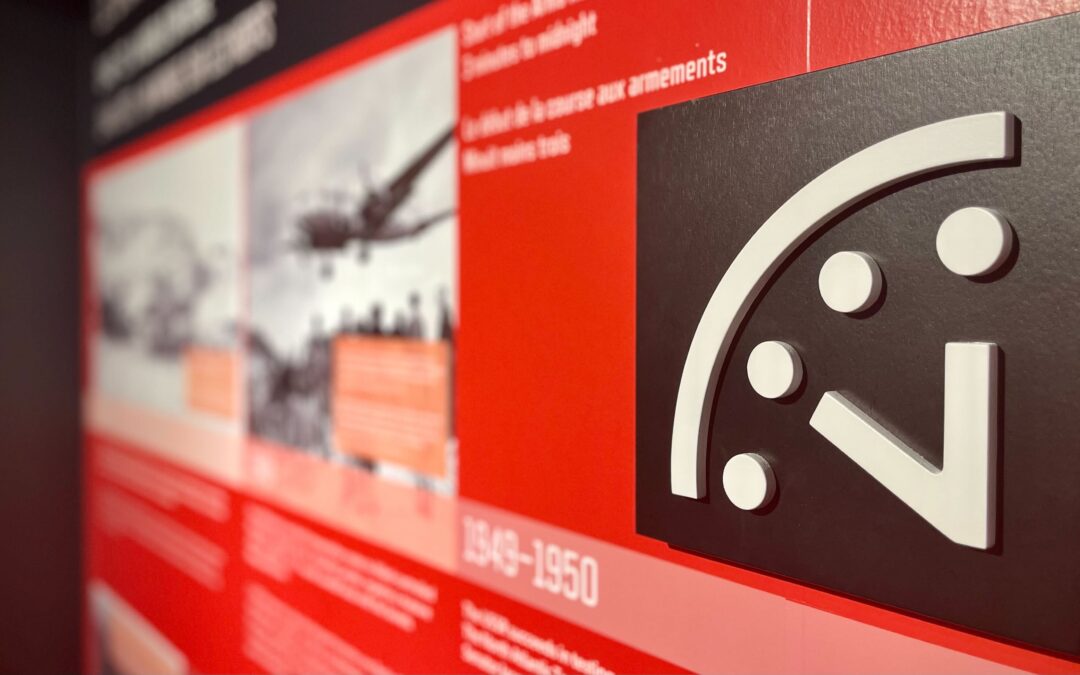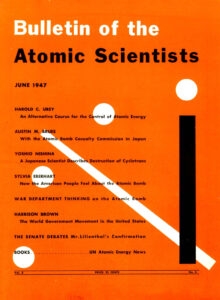
The Doomsday Clock, created by the Bulletin of the Atomic Scientists in 1947, is a symbolic representation of how close humanity is to global catastrophe — or, midnight. The concept of Doomsday Clock was created at a time of great danger for humanity — the United States and Soviet Union were headed toward a nuclear arms race during the Cold War. The clock also considers various other factors that are a reminder of the perils bringing us toward global catastrophe, including climate change and emerging man-made technologies. The clock’s original setting at the time of its invention was seven minutes to midnight, and in recent years, it has continued to tick closer, reflecting growing threats and serving as a stark reminder of the need for mass cooperation and action to address these existential risks.

Cover of the 1947 Bulletin of the Atomic Scientists issue, featuring the Doomsday Clock at “seven minutes to midnight”
The Doomsday Clock was designed by artist Martyl Langsdorf in 1947 for the cover of the June 1947 edition of the Bulletin, the first issue published as a magazine rather than a newsletter. Martyl — as she was known professionally — considered using the symbol for uranium in the magazine cover design, but wanted to more accurately convey the sense of urgency that was felt at the time. As a result, she sketched a clock to suggest that there was minimal time remaining to get atomic weapons under control, and the Doomsday Clock was brought into existence.
The Bulletin’s Science and Security Board later assumed the responsibility for determining the clock’s proximity to midnight. The Board is comprised of scientists and other experts with deep knowledge of nuclear technology and climate science, who often provide expert advice to governments and international agencies. The Board meets twice a year to discuss world events and update the clock as necessary, either shifting the hands closer to or further away from midnight based on current global conditions. They consider factors such as the number of nuclear weapons in the world, parts per million of carbon dioxide in the atmosphere, degree of acidity in our oceans, and the rate of sea–level rise.
As Canada’s most significant Cold War artifact that once operated as the country’s central communications headquarters during the Cold War, the Diefenbunker tells stories of national and international importance. Given this, the Doomsday Clock is a pertinent topic and recurring symbol within our Canada and the Cold War exhibition. The clock reappears to mark key events throughout the exhibition space, reminding viewers of how actions affect the world around us. It is a powerful visual used to inspire change and spark conversation on ways to push back the clock.

The Doomsday Clock was recently updated on January 23, 2024, and currently sits at 90 seconds to midnight — the closest it has ever been since 1947 — to reflect the continued state of unprecedented realities in the world. As the clock inches closer to midnight, it is crucial for individuals, governments, and organizations to take action to prevent catastrophic events and to work towards a more peaceful future. It is through collective effort and commitment to change that we can turn back the hands of time and secure a better tomorrow for all.
